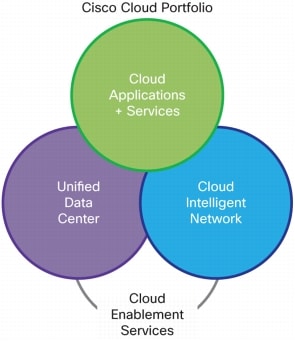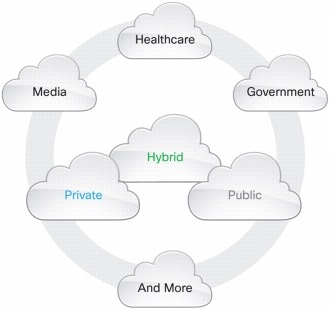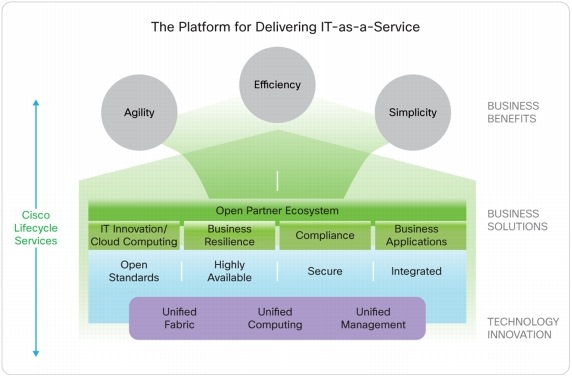What You Will Learn
We live in a world of many clouds, in which IT becomes IT as a Service (ITaaS), and in which people can collaborate dynamically and consume content on demand. Cisco® CloudVerse is a set of capabilities that enable customers to uniquely combine cloud business applications and services with the Cisco Unified Data Center and Cisco Cloud Intelligent Network (Figure 1).
Figure 1. Cisco CloudVerse Combines Cloud Business Applications and Services with Cisco Unified Data Center and Cisco Cloud Intelligent Network

Cisco CloudVerse combines computing, networking, and storage resources within the data center; connects clouds together; and delivers a high-quality cloud experience to the end user. Cisco CloudVerse combines solutions with industry-leading ecosystem partners to offer integrated services including collaboration, security, infrastructure as a service (IaaS), and video delivery that are pretested for private, public, and hybrid cloud use.
Introduction to Cloud Computing
Cloud computing is the next step in the evolution of the Internet. A cloud is a powerful combination of computing, networking, storage, and management resources, enabling a new generation of consumer and enterprise IT services that are available on demand and delivered economically to any device anywhere in the world without compromising security or function. Cloud computing is happening now.
Clouds are fundamentally changing the way that businesses and people consume services: enabling IT to be delivered as a service, evolving the way that people collaborate, and changing the way that content is delivered. Clouds enable the world to operate more simply, with greater agility and improved economics.
Early cloud discussions described a single, one-size-fits-all, giant cloud serving all customer needs. In reality, there are many types of clouds: private clouds, public clouds, hybrid clouds, and clouds built to meet the needs of specific industries such as healthcare, media, and government (Figure 2).
Figure 2. There Are Many Types of Clouds

We are moving to a world of many clouds, in which users experience cloud services anywhere, at any time, and on any device, and in which businesses want IT as a service.
Customer Challenge
Enterprises, service providers, small businesses, and governments are looking for cloud solutions to solve some of their biggest business and technology challenges: reducing costs, creating new levels of efficiency, and facilitating innovative business models that promote revenue growth.
The challenge and opportunity of the world of many clouds is to bring together cloud computing, the network, and storage, spread across multiple clouds composed of many thousands of infrastructure elements and an ever-increasing amount of content that must work together on demand and securely, delivering cloud services that empower people wherever and however they choose to consume applications.
When implemented successfully, the cloud will allow cloud providers to tightly align technology with business priorities; service providers to deliver new services and content to their customers; governments and emerging countries to consolidate and advance technology faster; partners to deliver cloud-ready networks, data centers, and cloud services to their customers; and consumers to instantly access new services and content.
The main challenge in the world of many clouds is to decide which cloud model is right for each organization and opportunity and to understand how best to connect with other clouds to achieve cloud's full potential: bringing together the people, processes, and technology to securely deliver cloud services, such as collaboration and video, in ways that benefit people however they choose to consume their services and applications.
Cisco CloudVerse
Cisco CloudVerse is a set of capabilities to deliver cloud that uniquely combines cloud business applications and services with the unified data center and cloud intelligent network. It brings together computing, networking, and storage resources within the data center and connects clouds together between data centers to deliver a high-quality cloud experience to the end user.
Cisco CloudVerse works with technologies from industry-leading ecosystem partners to offer integrated solutions and services including collaboration, security, IaaS, and video delivery that are pretested for private, public, and hybrid clouds.
Cisco CloudVerse cloud security helps customers reduce risk through the Cisco SecureX Architecture™, which enables consistent security policies and enforcement, up-to-date threat intelligence, greater scalability, and improved performance. Cisco cloud security helps remove cloud barriers so that customers can achieve the economies of scale and efficiency of cloud computing.
Cisco CloudVerse is delivered to customers by Cisco partners: trusted experts who will listen to your challenges and design and implement a solution that will help your business thrive and adapt to change. Cisco CloudVerse is supported by a portfolio of cloud enablement services (professional services) to help design, build, and manage cloud solutions and services offered by Cisco and our partners.
Cisco Unified Data Center
Cisco Unified Data Center is a simplified architecture that provides more efficient network operations, delivers greater IT agility for business innovation, and incorporates an open system for supporting multiple cloud and virtualization strategies. Cisco Unified Data Center architecture has three main components: Cisco Unified Fabric, Unified Computing, and Unified Management (Figure 3).
Cisco Unified Fabric
Delivery of high-performance IT services is critical to the data center, and Cisco has built its reputation on intelligent network delivery. The Cisco Unified Fabric component of Cisco Unified Data Center is based on the Cisco Nexus® family of switches and integrated network services that provide high-speed connectivity, high-availability, security, and consistent quality of experience for data center applications.
Cisco's fabric-based approach eliminates the tiered silo approach and inefficiencies of multiple network domains and replaces it with a flatter, unified fabric that consolidates SAN and network-attached (NAS) network segments over one high-performance, fault-tolerant fabric.
As enterprises become increasingly reliant on virtual resources, they encounter a correspondingly increased demand on their existing network infrastructure. The Cisco Unified Fabric architecture delivers massive scalability and resiliency by creating large pools of virtualized network resources that allow existing and new virtual assets to be easily moved and reprovisioned. Cisco's architecture simultaneously preserves the existing IT resources and eliminates the complexity of introducing new virtual machines and applications in the future.
Cisco Unified Computing
Data center efficiency begins with system-level infrastructure that integrates computing with access and storage networking into a scalable platform for x86-based applications. The Cisco Unified Computing System™ (Cisco UCS™) is the result of true innovation and engineering, not just the integration of two existing technologies, and Cisco UCS is reducing data center costs and increasing data center efficiency in every type of industry and vertical segment. Only Cisco UCS provides a single, open, programmable management interface that can scale to hundreds of blades and thousands of virtual machines. Only Cisco UCS can deliver a unified operational model across physical, virtual, and cloud infrastructures.
Cisco UCS uses model-based service templates to automate the entire server configuration process, and each template can easily configure one or hundreds of servers using role- or service-based policies. These templates can reduce the number of configuration steps from more than a hundred to just two. Meanwhile, IT managers have greater visibility and control over the entire computing environment.
When used within the Cisco Unified Fabric framework, Cisco UCS gives IT managers a wire-once platform for providing highly elastic and agile pools of virtualized resources. Cisco Fabric Extender Technology (FEX Technology) also reduces the number of interfaces, cables, and switches needed to support Cisco blade servers. This consolidation alone cuts the cost of per-server infrastructure in half and also reduces energy and cooling requirements. Through open APIs, Cisco UCS also gives data centers exceptional flexibility in platform choice and network integration and migration.
Cisco Unified Management
Simplicity and speed are essential to the flexibility required of IT. Cisco offers the industry's only self-service, open management platform for integrating all data center resources, including resources for computing, applications, network services, security, storage, and cloud computing. The Cisco Unified Management component of Cisco Unified Data Center allows transparent management across physical and virtual resources to simplify and accelerate delivery of IT services within the data center or in a cloud environment.
Cisco Unified Management solutions include Cisco UCS Manager, which provides centralized and embedded management of all computing hardware and software components; Cisco Network Services Manager, which provide fast and automatic provisioning and deployment of various network components; and Cisco Intelligent Automation for Cloud, which provides the functions to support an IT service catalog, self-service provisioning, automation, and service orchestration. Cisco Intelligent Automation for Cloud is optimized for Cisco UCS and Cisco Nexus infrastructure, but it is designed for heterogeneous IT environments, offering sophisticated service management functions such as policy-based governance, service assurance, lifecycle management, and pay-per-use tracking. In many cases, Cisco Unified Management solutions can completely automate maintenance tasks previously performed manually, thereby reducing complexity and accelerating time to service. Open APIs allow integration with an open ecosystem of application, virtualization, storage, and system management partners to extend the unified management concept even further within the data center.
Figure 3. Cisco Unified Data Center Components

Through its considerable investment in cloud-based solutions, Cisco also provides complete and automated cloud management through the Cisco Unified Management self-service portal, enabling data center personnel, for the first time, to effectively control every aspect that affects cloud performance, security, and reliability from the hardware layer all the way up the stack to cloud-based applications with its Cisco UCS and Cisco Network Services Manager components.
Cloud Intelligent Network
Secure, reliable, and predictable delivery of cloud services is an essential part of robust cloud service delivery. Whether your need is to deliver private or hybrid cloud services at disparate campuses or enterprise-class public cloud commercial services, today's demanding users are rarely prepared to accept a best-efforts approach to service access.
To help ensure your success in meeting your users requirements, Cisco has developed a comprehensive set of solutions called the Cisco Cloud Intelligent Network that are designed to work together transparently. The Cisco Cloud Intelligent Network integrates with the Cisco Unified Data Center to provide a powerful end-to-end delivery platform for cloud services.
The Cisco Cloud Intelligent Network extends beyond the walls of individual data centers to provide peering and interconnect capabilities between data centers, allowing service integration, flexibility, and agility for provisioning entertainment, information, and communication-based services. Data center resources are securely joined together across the network using Multiprotocol Label Switching (MPLS) peering, scalable interconnect, and secure Internet gateway capabilities. With the Cisco Cloud Intelligent Network, providers can achieve highly secure, logical, and physical separation of services, helping provide privacy and security for business and residential customers.
Cisco believes that an intelligent network is the fundamental foundation that connects the world of many clouds. The Cisco Cloud Intelligent Network has intelligence and scalable policies that are built into the network to provide a consistent and secure user experience regardless of the user location and number of cloud platforms involved in the service delivery.
The Cisco Cloud Intelligent Network strategy encompasses three areas necessary to uniquely enable your cloud services in an increasingly complex market:
• Cisco Cloud Customer Connect enables the delivery of enterprise-class services from the service delivery source to the ultimate user while securely helping ensure that quality-of-service (QoS) requirements are met with business-oriented policy controls and context-aware security capabilities.
• Cisco Cloud-to-Cloud Connect addresses the growing need to connect clouds and optimize the sourcing of data and content from the decentralized delivery centers within the cloud. Meeting this challenge requires extending the data center fabric across data centers and clouds as well as implementing technologies that enable close integration of the network with the cloud delivery solution.
• Cisco Network Management and Automation is of critical importance in the cloud world because of the ever-increasing requirements for agility mandated by the dynamic nature of the cloud.
Cisco CloudVerse includes Cisco Cloud Intelligent Network as the common platform to connect the consumer, the enterprise, and the service provider to innovative capabilities within, between, and beyond the cloud. The result is an entirely new way to create dynamic interconnections and harness capabilities that facilitate an integrated approach to service delivery.
Cisco Cloud Applications and Services
IT focus is shifting to service delivery as content and applications are increasingly being delivered on demand and to mobile users. Organizations can achieve significant benefits by taking advantage of applications and services offered through the cloud, which:
• Deliver consistency of service across devices
• Ensure access to an always-current version
• Support easy service procurement and activation
• Enable rapid deployment at scale
• Are inherently "business-to-business ready" for customers, partners, and suppliers
• Shift IT spend from capital expenditures (CapEx) to operating expenses (OpEx)
• Allow organizations to focus on "core" vs. "context" as appropriate
The critical factor is still about making sure it works and making sure your teams can work. Cisco is focused on enabling a compelling user experience with every service delivered from the cloud. These services can be provided anywhere, on any device, at any time with the security, performance, and reliability previously possible only with traditional on-premises deployments.
Cisco offers a portfolio of cloud-based business applications and services for enterprises to consume directly or as a service from a Cisco partner or service provider:
• Hosted services that include Cisco Hosted Collaboration Solution (HCS) and Cisco TelePresence Callway. Through our service provider partners, these services support organizations that want access to market-leading enterprise voice and Telepresence services and collaboration applications without the overhead of on-premises implementation and maintenance.
• Cisco's Collaboration Cloud portfolio, an innovative set of applications and services that allow users to enjoy a rich, interactive, and compelling user experience enabled by the industry-leading suite of Unified Communications, TelePresence, Customer Contact, Meetings, Instant Messaging, Presence, and applications in the market. Now available as a hosted service from the cloud from Cisco and from a select group of Cisco Partners and service providers, without compromising the user experience.
• Cisco Videoscape that is an innovative service-provider solution that is reinventing the delivery of television experiences.
• Cisco Cloud Security solutions providing effective, scalable, and always-updated web and email security. Cisco ScanSafe Cloud Web Security analyzes web requests for malicious, inappropriate, or acceptable content. Cisco IronPort Cloud Email Security helps protect organizations from spam, viruses, and blended threats.
• Extensive portfolio of third-party cloud services and applications - pretested for CloudVerse.
Cisco Cloud Applications and Services help companies give users what they need to collaborate; when, where, and how they need it. With flexible deployment models based on cloud provisioning, Cisco solutions support the mobile, social, visual, and virtual aspects of effective collaborative environments. The applications enable more natural collaboration, helping people hear and see one another, meet, share ideas and content, and improve their working relationships and productivity.
Enabling Providers to Deliver Cisco Collaboration Services
Cisco enables providers to deliver cloud services with integrated pretested Cisco and partner infrastructure solutions. Building on Cisco's end-to-end collaboration architecture and Cisco Validated Designs, partners can build cloud and collaboration services based on a continuingly evolving and expanding portfolio of Cisco Collaboration solutions and architectural blueprints and light-touch services. These designs help ensure security and full management across the collaboration suite for a multimedia, consistent user experience, anywhere, with any content, on any device, and in any consumption model. To create a comprehensive ecosystem of cloud solutions, Cisco partners use Cisco TelePresence® Exchange System and Cisco Hosted Collaboration Solution (HCS).
Delivering Cisco Collaboration Cloud Applications
Cisco Collaboration Cloud Applications and Services allow companies to deploy flexible cloud provisioning models to give users what they need to collaborate whenever, wherever, and however they need it. Using world-class partners to lead the service implementations, collaboration offerings delivered by Cisco include Cisco WebEx® meetings, instant messaging, and presence and Cisco TelePresence.
Cloud Enablement Services Portfolio
The Cloud Enablement Services portfolio enables you to accelerate deployment of your cloud solutions and applications and include professional and technical services to facilitate optimal operation of collaboration and video technologies in a cloud. Cisco and our partners offers deep expertise in four cloud service categories: cloud strategy, cloud planning and design, cloud implementation, and cloud optimization. Cisco and our partners have the services experience and expertise to help you accelerate your time to market, reduce costs, and quickly realize a return on your cloud investment.
Cisco Cloud Enablement Services include:
• Cloud Enablement Services for Building IaaS Clouds
• Cloud Enablement Services for Adopting Clouds
Cloud Enablement Services for Building IaaS Clouds
Cloud Enablement Services for Building IaaS Clouds provide customized strategy, planning and design, implementation, and optimization based on your targeted private cloud offering. Drawing on extensive experience delivering secure end-to-end virtualized data centers, Cisco provides a comprehensive, architectural approach for enabling IaaS that considers the people, processes, and technologies involved across your network, compute, and storage resources. Services include Cloud Strategy Service, Cloud Planning and Design Service, Cloud Implementation Service, and Cloud Optimization Service - all with a focus on cloud security.
Cloud Enablement Services for Adopting Clouds
Cloud Enablement Services for Adopting Clouds deliver the expert help you need to accelerate the adoption of a public cloud model based on your current environment and business goals. The service enables businesses to optimize existing infrastructure to realize the full benefits of a public cloud. To facilitate your decision making around a cloud migration, Cisco Cloud Enablement Services for Adopting Clouds provide two service modules, Cloud Adoption Strategy Services and Cloud Adoption Planning Services.

Thanks for sharing this wonderful information on Secure Internet Gateway
ReplyDeleteI am grateful to this blog site providing special as well as useful understanding concerning this subject.
ReplyDeleteit support company